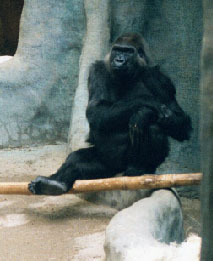
| The gorilla has a unimale social system and a polygynous mating system. The basic group is composed of one mature silver-back male (the leader of the group), one subadult or black-back male (about 8 to 12 years old), three adult females, and two to three young (less than 8 years old) (Estes, 1991). Both males and females emigrate from their natal troop (Estes, 1991). When females leave they travel a long distance from their natal troop and either join a lone silver-back male or a group with only a few females (Estes, 1991). Females may emigrate to avoid inbreeding because when she reaches sexual maturity the silver-back male is most likely her father (Stewart and Harcourt, 1987). There is a hierarchy amongst the females within the group, and a female’s rank is passed on to her offspring (Estes, 1991). The female’s rank is based upon when she became a member of the group, so the first female a lone silver-back makes part of his group would be the highest ranking female (Estes, 1991). High rank allows that female and her offspring to be closer to the silver-back male, and this could decrease the risk of predation (Estes, 1991). Grooming occurs between the silver-back and the adult females and the juveniles and the silver-back and between juveniles (Stewart and Harcourt, 1987). Males will only stay in their natal group if they are likely to be able to mate with females (Estes, 1991). This occurs if the silver-back male is old and is ready to die soon, the son will inherit the group (Estes, 1991). |  |